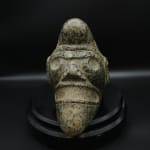Taíno Toirgonolito Zemí, AD 1200 - AD 1500
Greenstone
21 x 30 cm
8 1/4 x 11 3/4 in
8 1/4 x 11 3/4 in
AM.0078
Further images
-
(View a larger image of thumbnail 1
)

-
(View a larger image of thumbnail 2
)

-
(View a larger image of thumbnail 3
)

-
(View a larger image of thumbnail 4
)

-
(View a larger image of thumbnail 5
)

-
(View a larger image of thumbnail 6
)

-
(View a larger image of thumbnail 7
)

-
(View a larger image of thumbnail 8
)

-
(View a larger image of thumbnail 9
)

-
(View a larger image of thumbnail 10
)

Taino culture flourished in the Caribbean between c.1200-1500. The arrival of the Spanish in 1492 resulted in its rapid decline but objects such as this striking trigonolitos, also known as...
Taino culture flourished in the Caribbean between c.1200-1500. The arrival of the Spanish in 1492 resulted in its rapid decline but objects such as this striking trigonolitos, also known as a three-pointer, testify to high levels of craftsmanship. The Taino left no written language so our knowledge about them derives solely from archaeology and the testimonials of the Spanish settlers. As a result, although significant numbers of three-pointers survive, their precise function within Taino society is unclear. The central cone of these triangular objects has been interpreted in a variety of ways. Suggestions include manioc shoots (one of the main crops of the Taino), volcanoes, the roofs of Taino houses, phalluses and the human breast. None of these theories has been universally accepted and the precise origins of the shape are likely to remain a mystery. Despite this many scholars agree that these ceremonial objects were symbols of power and fertility. This seems to be supported by a letter written by Columbus in which he reports on his findings among the Taino, ‘Equally the majority of caciques (chiefs) have three stones to which they and their people have great devotion. One they say is for the fertility of the grain and vegetables that they grow; the next for mothers to give birth without pain, and the third for the water and sun when they have need.’
Three-pointers were made in various sizes and have a long history that predates the Taino fluorescence. Small examples with little decoration have been dated to c.400-200 BC. However anthropomorphic examples such as this one, with intricate incised decoration, played a crucial part in Taino public life. As Columbus’ testimony implies they were the preserve of the ruling elite and their ownership was synonymous with power.
One side of the piece depicts a skull-like human face with circular sunken orbits and nostrils. The artist has made excellent use of his material, exploiting the contrast of textures between highly polished areas and the coarser surface of the facial details. The reverse features a section of incised geometric motifs which may recall textile designs or tattoos worn by the Taino elite. The carving is particularly controlled and precise and the green-flecked stone has a strong aesthetic appeal in its own right. This is a Taino masterpiece of great power and expression.
Three-pointers were made in various sizes and have a long history that predates the Taino fluorescence. Small examples with little decoration have been dated to c.400-200 BC. However anthropomorphic examples such as this one, with intricate incised decoration, played a crucial part in Taino public life. As Columbus’ testimony implies they were the preserve of the ruling elite and their ownership was synonymous with power.
One side of the piece depicts a skull-like human face with circular sunken orbits and nostrils. The artist has made excellent use of his material, exploiting the contrast of textures between highly polished areas and the coarser surface of the facial details. The reverse features a section of incised geometric motifs which may recall textile designs or tattoos worn by the Taino elite. The carving is particularly controlled and precise and the green-flecked stone has a strong aesthetic appeal in its own right. This is a Taino masterpiece of great power and expression.









